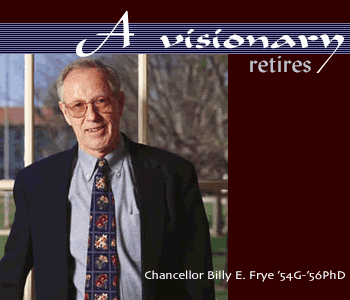|

“Our
central aim is to make Emory one of the best
universities in the nation and in the world.”
SO
BEGINS A Vision for Emory, the second of two
seminal documents by Chancellor Billy E. Frye ’54G-’56PhD
that illuminate a set of guiding principles for the University’s
future. The fruit of many hours spent in conversation with faculty
and members of the Emory community, A Vision for Emory
outlines ten proposed transitions and emerging trends that,
Frye concluded, “will result in a great and dynamic university
that is building on its roots to produce an excellent institution
that is at once powerful in its intelligence, moral in its sensibilities,
global in its perspective, and distinctive in its cast.”
In
all Frye’s fifteen years at Emory, no one ever accused
him of setting his sights too low. From the day he arrived at
the University in 1986 to become dean of the graduate school
and vice president of research, Frye was unswerving in his pursuit
of excellence, raising the bar ever higher in his quest to see
Emory gain sure footing among the nation’s topmost institutions.
As the University’s first provost from 1988 to 1997, its
interim president in 1993, and then its fourth chancellor, Frye
influenced nearly every facet of University life through “his
appeal, made in countless ways, that the University and its
faculty live up to the highest standards of scholarship, devotion
to teaching, and community service,” says President William
M. Chace.
Last
spring, Frye announced his retirement. He will be spending most
of his time on his farm in the north Georgia mountains, where
he will turn his attention to simpler pleasures: “Growing
orchids, gardening, reading, and eventually some fishing, I
suppose,” he says. Frye leaves a legacy that will almost
certainly continue to guide Emory’s growth for generations
to come, clearly expressed in what he considers his proudest
achievements, A Vision for Emory and its 1994 companion
piece, Choices and Responsibility: Shaping Emory’s Future.
Frye’s
highest priorities for Emory included balancing quality teaching
with cutting-edge research, encouraging interdisciplinary collaboration,
maintaining a sense of community in the face of rapid physical
expansion, and enriching the University’s ties to the surrounding
world. Working closely with faculty and administrators, he led
myriad efforts to further these goals and set initiatives in
motion that would ensure their long-term progress.
“Choices
and Responsibility merely articulated the goals that most
folks would see as essential for any major university worth
its salt,” Frye says. “But it interjected into the
conversation the importance of consideration of balance among
these activities, consideration of the needs and the potential
of the University as a whole, and, of course, the importance
of being faithful to our values as we pursue greater recognition
from within the profession and the general public.”
As
Emory’s growth skyrocketed in the early 1990s, particularly
in the areas of medical research and the health sciences, Frye
strove to help the University maintain a balanced identity.
Over the course of almost ten years as provost–the University’s
chief academic officer–he was a tireless champion of the
arts and sciences at Emory and a catalyst for the formation
of the highly successful Graduate Division of Biomedical and
Biological Sciences. George Jones, Goodrich C. White Professor
of Biology, was dean of the Graduate School of Arts and Sciences
during much of Frye’s tenure as provost, and had previously
worked with Frye at the University of Michigan.
“The
growth and development of the graduate school as a real player
in the intellectual life of the community was something Billy
started as dean in 1986,” Jones says, “He continued
to play a critical role when I was dean of the graduate school.”
The
impact of Frye’s vision has reached far beyond the University
campus, Jones says.
“Choices
and Responsibility was a document that not only challenged
us to think deeply about Emory, but challenged a lot of people
at universities across the country to think deeply about the
nature of American universities in the twenty-first century,”
Jones says. “Many leaders used it to help crystallize their
own thinking about their own institutions. It really played
a role in helping to shape educational institutions around the
country.”
Frye
intended to retire in 1997, when President Chace unexpectedly
offered him the title of chancellor, a post that has been sporadically
occupied during Emory’s history. In this position, he co-chaired
the Council on Information Resources and Technology, and served
as one of four co-chairs of the University’s Year of Reconciliation.
Despite
his relentless drive for superlative quality and standards,
Frye was also recognized for his “patience, his thoroughgoing
integrity, and his sense of humor amid everything,” says
Chace.
“He
brought a civility to the performance of his duties that I think
was critical in helping to develop the kind of collegial environment
that now exists in the structure and hierarchy at Emory,”
Jones says. “There were battles to be fought, but he did
so in a way that allowed them to be fought without any lingering
animosity. As difficult as these were, they were much less so
than they would have been had his character and personality
been different.
”It
is a tribute to Billy that I have spoken to a number of people
across the country who know of him,” Jones says. “They
have said that when they think of the model for a provost at
an American university, they think of Billy Frye.” –P.P.P.
|